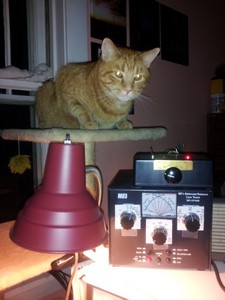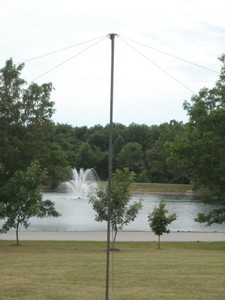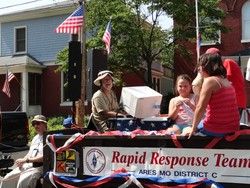 July 18, 2012 Editor: Ward Silver, NØAX | ||||||
IN THIS ISSUE
NEW HF OPERATORS - THINGS TO DO The IOTA Contest has some rule changes this year to bring the focus back to - what else? - working islands! If you can operate from one, so much the better, but if not this is a great way to start IOTA chasing and maybe add a DXCC entity to your totals, too! BULLETINS Your editor is taking a short vacation so this edition is a bit attenuated from its usual volume. The newsletter will return to 'normal' in subsequent editions. BUSTED QSOS The DMC RTTY Contest was listed last weekend due to out-of-date web information - it's this weekend! Contest sponsors - please update your websites well in advance of the contest. CONTEST SUMMARY Complete information for all contests follows the Conversation section Jul 21-22
Jul 28-29
Bob WA1Z has released another version of the Super Check Partial database files effective on July 11th, 2012. He requests you send Cabrillo-formatted logs for input to the database files to logs@supercheckpartial.com. Logs from any contest within the last 24 months are always appreciated.
We have an anniversary to celebrate as Tim K3LR relayed the following, "NASA Telstar was launched by NASA on July 10, 1962, from Cape Canaveral, Fla., and was the first privately sponsored space-faring mission. Two days later, it relayed the world's first transatlantic television signal, from Andover Earth Station, Maine, to the Pleumeur-Bodou Telecom Center, Brittany, France. Developed by Bell Telephone Laboratories for AT&T, Telstar was the world's first active communications satellite and the world's first commercial payload in space. It demonstrated the feasibility of transmitting information via satellite, gained experience in satellite tracking and studied the effect of Van Allen radiation belts on satellite design. The satellite was spin-stabilized to maintain its desired orientation in space. Power to its onboard equipment was provided by a solar array, in conjunction with a battery back-up system." The Telstar rounded shape still virtually defines 'satellite' in the public's imagination even today.
Web Site of the Week - Have a look at an article Andy K1RA wrote covering the Grid Pirates Contest Group operation in this past June VHF contest. The web site was down due to the intense storms in the east last week but is back up now. WORD TO THE WISE Check the rules (contest and licensing) before you go on a contest DXpedition. Most people might not know this but a US General class license, which has HF privileges, doesn't always give you the same privileges in a CEPT country. Many of the countries in the Caribbean are CEPT countries. Say, for example, you went to PJ2 to operate ARRL DX Contest. If you operate on HF and you have a General class license, you are breaking the reciprocal licensing rules. When the privileges authorized by the FCC license grant are Advanced or Amateur Extra Class operator privileges, the U.S. citizen is granted CEPT Radio Amateur License privileges, in accordance with CEPT Recommendation T/R 61-01 (as amended). When the privileges authorized by the FCC license grant are General Class operator privileges, the U.S. citizen is granted CEPT Novice Radio Amateur License privileges, in accordance with ECC Recommendation (05)06 (as amended). Both recommendations are available online. (Thanks, Jeff KU8E) The next Potomac Valley Radio Club webinar is "Update on Cycle 24 and More" to be held on July 18 and again on July 21. K9LA's August 2009 PVRC webinar discussed solar minimum between Cycle 23 and 24, and the early status of Cycle 24. This new webinar will review our recent solar minimum, review Cycle 24's present status, and discuss propagation in relation to the progress of Cycle 24. Two other topics to be discussed will be the effect of trees on HF and MF propagation, and the best height for your antenna. See the PVRC website for free pre-registration or to view archived presentation. (Thanks, Ken K4ZW) WRTC-2014 Team Selection Director, Dan K1TO, reports that, "The latest official published contest results that qualify for WRTC 2014 are now posted on the WRTC 2014 website. 27 qualifying events are now included, roughly one-half of the 55 total events. 36 qualifying events have now taken place, which means that you still have 19 more events in which to operate and move up in the standings!"
Indiana QSO Party results are now online and plaques will be awarded later this summer. (Thanks, Mel KJ9C) Champ E21EIC reports on the latest HS/E2 prefix assignments - the HS prefixes are nearly gone. Watch for more interesting E22 through E29 prefixes to hit the airwaves including the 42 new licensees that will get HF permissions. Foreign hams licensed in Thailand will still be assigned HSØZxx call signs. OPERATING TIP If you are working with a new operator following Field Day, now is the time to help them learn good habits. One of the first lessons should be - no extra verbiage. Just give the minimum exchange in the right order without rushing! There's no better opportunity to start trimming the excess baggage of "Please copy..." and "You are..." and repeating the exchange. Start 'em out right! Tom W8JI recommends a couple of documents about the effect of coax construction, illustrated in this West Penn Wire paper, on mechanical robustness - not something considered by most hams. "Although the test frequency and method is not described, this [Commscope paper] shows the difference between quad shield and single foil and braid is 7 dB before 10,000 flexes and 13 dB after 10,000 flexes."
From the ARRL Propagation Bulletin ARLP013, "Q-up Now" has a fascinating new set of real-time propagation tools developed by a team associated with the Utah State University Space Weather Center. They use a real-time model of the ionosphere called GAIM (GlobalAssimilation of Ionospheric Measurements) which is updated every 15minutes with 10,000 global TEC (Total Electron Content) measurementsto simulate the F layers. Then they use the ABBYNormal Model for the D and E layers, and the two models are combined to give a complete representation of the global ionosphere. Using the HF Availability feature you can model real-time propagation for the frequency of your choice, including 160 meters, between any two points and beyond out to the antipodes. DIY Equipment Labeling was the headline for an ARRL E-Letter story in the July 11 issue. "Here is an interesting DIY project for labeling your equipment with tape. This tape should be fairly permanent if you use pop rivets to fasten it to something. Seems like it would make a good equipment ID for when you have to take expensive stuff into the field (emergency exercises, Field Day, or actual emergencies). And several locals swear by E-6000 glue as an alternative for application of the labels. --Rick Herndon, K5FNI, Mathis, Texas; Life Member, ARRL; Official Emergency Station" On the first day of Field Day, my true love gave to me... Here's a packing list for the WRTC-2014 "test flight" during last weekend's IARU HF contest. They put fifteen stations on the air, WRTC-style - checking things out a couple of years in advance! From reports, the stations worked well and what issues did arise were and are manageable - good job!
Multiply all that by four and you have some idea of the scope of the full WRTC effort coming up in 2014. Clubs and other groups have helped make this possible through the tent sponsorship program. I have to go lie down now after just thinking about all of it. The wind can mis-align an antenna - who knew? Just about every ham with a beam and a rotator knows...but this fact of life has to be learned sometime! Technical Web Site of the Week - An interesting and extended discussion took place over the past week on the CQ-Contest reflector regarding bandpass filters, stubs, coupling between antennas, and receiver front-end protection. So many topics were being covered that summarizing them here just wouldn't do it justice. Browse to the searchable archives and look for the "Bandpass filter" thread.
A little summertime ditty is provided for you to hum while chasing all the DX stations through their "packet pileups". Don't forget to QNY! 73, Ward NØAX Skimmertime Miscopied from Ira Gershwin's "Summertime" by Dr Beldar Skimmertime, Your band map's full, One of these openings, And in that opening, 18 July through 31 July An expanded, downloadable version of QST's Contest Corral in PDF format is available. Check the sponsor's Web site for information on operating time restrictions and other instructions. HF CONTESTS North American QSO Party RTTY--Digital, from Jul 21, 1800Z to Jul 22, 0600Z. Bands (MHz): 3.5-28. Exchange: Name and S/P/C. Logs due: 14 days. Rules NAQCC Monthly QRP Sprint--CW, from Jul 19, 0030Z to Jul 19, 0230Z. Bands (MHz): 3.5-14. Monthly on 2nd Tuesday or 3rd Wednesday local time (alternating). Exchange: RST, S/P/C, and NAQCC mbr nr or power. Logs due: 4 days. Rules DMC RTTY Contest--Digital, from Jul 21, 1200Z to Jul 22, 1200Z. Bands (MHz): 3.5-28. Exchange: RST and serial. Logs due: Aug 15. Rules Feld-Hell Ten Meter Sprint--Digital, from Jul 21, 1600Z to Jul 21, 1800Z. Bands (MHz): 28. Monthly on 3rd Saturday. Exchange: RST, S/P/C, Feld-Hell member nr. Logs due: 7 days. Rules RSBG Low Power Contest--CW, from Jul 22, 0900Z - multiple operating periods. Bands (MHz): 3.5-7. Exchange: RST, serial, power. Logs due: Jul 30. Rules Run For the Bacon--CW, from Jul 23, 0100Z, see website. Bands (MHz): 1.8-28. Monthly on 3rd Sunday night (local). Exchange: RST, S/P/C, Flying Pig nr or power. Rules IOTA Contest--Phone,CW, from Jul 28, 1200Z to Jul 29, 1200Z. Bands (MHz): 3.5-28. Exchange: RS(T), serial, IOTA number if island. Logs due: 3 weeks. Rules MARAC US Counties QSO Party--Phone,CW, from Jul 28, 1400Z - multiple operating periods. Bands (MHz): 3.5-28. CW - 50 kHz above band edge; SSB - 1.85, 3.85, 7.25, 14.27, 21.4, 28.4, 50.135, 146.53. Exchange: RS(T), state and county, or "DX". Logs due: Aug 31. Rules New Jersey QSO Party--Phone,CW, from Jul 28, 1600Z to Jul 29, 1600Z. Bands (MHz): 3.5-28, 50,144. Exchange: Serial and NJ county or S/P or "DX". Logs due: Aug 15. Rules Flight of the Bumblebees--CW, from Jul 29, 1700Z to Jul 29, 2100Z. Bands (MHz): 7-28. Exchange: RST, S/P/C, Bumblebee nr or power. Logs due: Aug 12. Rules VHF+ CONTESTS 144 MHz Digital EME Championship--Digital, from Jul 21, 0000Z to Jul 22, 2400Z. Bands (MHz): 144. Exchange: TMO or RST and R. Logs due: 14 days. Rules CQ WW VHF Contest--Phone,CW,Digital, from Jul 21, 1800Z to Jul 22, 2100Z. Bands (MHz): 50,144. Exchange: 4-char grid square. Logs due: Sep 1. Rules New Jersey QSO Party--Phone,CW, from Jul 28, 1600Z to Jul 29, 1600Z. Bands (MHz): 3.5-28, 50,144. Exchange: Serial and NJ county or S/P or "DX". Logs due: Aug 15. Rules LOG DUE DATES 18 July through 31 July
ARRL Information Click here to advertise in this newsletter. Your One-Stop Resource for Amateur Radio News and Information ARRL membership includes QST, Amateur Radio's most popular and informative journal, delivered to your mailbox each month. Subscribe to NCJ - the National Contest Journal. Published bimonthly, features articles by top contesters, letters, hints, statistics, scores, NA Sprint and QSO Parties. Subscribe to QEX - A Forum for Communications Experimenters. Published bimonthly, features technical articles, construction projects, columns and other items of interest to radio amateurs and communications professionals. Free of charge to ARRL members: Subscribe to The ARRL Letter (weekly digest of news and information), the ARES E-Letter (monthly public service and emergency communications news), Division and Section news -- and much more! ARRL offers a wide array of products to enhance your enjoyment of Amateur Radio. Visit the site often for new publications, specials and sales. Donate to the fund of your choice -- support programs not funded by member dues! Reprint permission can be obtained by sending email to permission@arrl.org with a description of the material and the reprint publication. ACKNOWLEDGEMENTS ARRL Contest Update wishes to acknowledge information from WA7BNM's Contest Calendar and SM3CER's Contest Calendar. | ||||||











